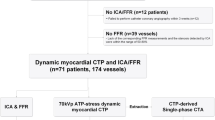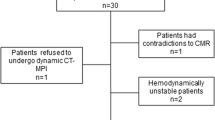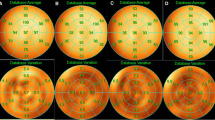Abstract
Background
Coronary artery calcium is an important marker of coronary artery disease. Myocardial perfusion imaging (MPI) using PET-CT technology requires a CT scan for attenuation correction (CTAC) but is not used routinely to measure coronary calcium burden. This study aimed to determine if a low-dose CTAC scan can also accurately quantify coronary artery calcium.
Methods
Twenty-three patients underwent both a traditional coronary artery calcium scan on a dedicated cardiac CT scanner (CAC-CT) and a myocardial perfusion scan on a hybrid PET-CT scanner. The standard MPI protocol includes rest and stress-matched PET and CTAC scans. The post-stress CTAC scan was modified to approximate the CAC-CT scan protocol while maintaining ~0.5 mSv dose. Coronary artery calcium scores were compared between the Ca-CTAC and CAC-CT scans.
Results
The modified Ca-CTAC scan showed a trend toward slight decreases in segmental stress perfusion of 2-3.5% in the anterior wall segments (P < 0.05). Correlation and agreement between the proposed Ca-CTAC and standard CAC-CT calcium scores at the optimal threshold of 110 HU were also excellent (r 2 = 0.99, κ = 1.0). There was a small difference in the regression slope vs unity: Ca-CTAC = 0.96 × CAC (P < 0.05), but the categorical classification of calcium was accurate in all twenty-three patients (κ = 1.0).
Conclusion
A single low-dose rest CTAC scan can be used for accurate attenuation correction of rest and stress PET perfusion images, thus allowing a post-stress CTAC scan to be optimized for improved quantification of coronary artery calcium without increasing radiation dose vs standard protocols.







Similar content being viewed by others
References
Chow BJ, Wells GA, Chen L, Yam Y, Galiwango P, Abraham A, et al. Prognostic value of 64-slice cardiac computed tomography: Severity of coronary artery disease, coronary atherosclerosis and left ventricular ejection fraction. J Am Coll Cardiol 2010;55:1017–28.
Hou ZH, Lu B, Gao Y, Jiang SL, Wang Y, Li W, et al. Prognostic value of coronary CT angiography and calcium score for major adverse cardiac events in outpatients. JACC Cardiovasc Imaging 2012;5:990–9.
Einstein AJ, Johnson LL, Bokhari S, Son J, Thompson RC, Bateman TM, et al. Agreement of visual estimation of coronary artery calcium from low-dose CT attenuation correction scans in hybrid PET/CT and SPECT/CT with standard agatston score. J Am Coll Cardiol 2010;56:1914–21.
Mylonas I, Kazmi M, Fuller L, deKemp RA, Yam Y, Chen L, et al. Measuring coronary artery calcification using positron emission tomography-computed tomography attenuation correction images. Eur Heart J Cardiovasc Imaging 2012;9:786–92.
Kaster T, Mylonas I, Renaud JM, Wells GA, Beanlands RS, deKemp RA. Accuracy of low-dose rubidium-82 myocardial perfusion imaging for detection of coronary artery disease using 3D PET and normal database interpretation. J Nucl Cardiol 2012;19:1135–45.
Klein R, Adler A, Beanlands RS, deKemp RA. Precision-controlled elution of a 82Sr/82Rb generator for cardiac perfusion imaging with positron emission tomography. Phys Med Biol 2007;52:659–73.
Klein R, Renaud JM, Ziadi MC, Thorn SL, Adler A, Beanlands RS, et al. Intra- and inter-operator repeatability of myocardial blood flow and myocardial flow reserve measurements using rubidium-82 PET and a highly automated analysis program. J Nucl Cardiol 2010;17:600–16.
Dilsizian V, Bacharach SS, Beanlands RS, Bergmann SR, Delbeke D, Gropler RJ. ASNC imaging guidelines for nuclear cardiology procedures: PET myocardial perfusion and metabolism clinical imaging. J Nucl Cardiol 2009;16:651–81.
Cerquiera MD, Weissman NJ, Dilsizian V, Jacobs AK, Kaul S, Laskey WK, et al. Standardized myocardial segmentation and nomenclature for tomographic imaging of the heart: A statement for healthcare professionals from the Cardiac Imaging Committee of the Council on Clinical Cardiology of the American Heart Association. Circulation 2002;105:539–42.
Abunassar J, Yam Y, Chen L, D’Mello N, Chow BJ. Usefulness of the agatston score = 0 to exclude ischemic cardiomyopathy in patients with heart failure. Am J Cardiol 2011;107:428–32.
Ziadi MC, deKemp RA, Williams KA, Guo A, Chow BJ, Renaud JM, et al. Impaired myocardial flow reserve on rubidium-82 positron emission tomography imaging predicts adverse outcomes in patients assessed with ischemia. J Am Coll Cardiol 2011;58:740–8.
Herzog BA, Husmann L, Valenta I, Gaemperli O, Siergrist PT, Tay FM, et al. Long-term prognostic value of 13 N-ammonia myocardial perfusion PET: Added value of coronary flow reserve. J Am Coll Cardiol 2009;54:150–6.
Hachamovitch R, Kang X, Amanulla AM, Abidov A, Hayes SW, Friedman JD, et al. Prognostic implications of myocardial perfusion single photon emission computed tomography in the elderly. Circulation 2009;120:2163–5.
Agatston AS, Janowitz WR, Hildner FJ, Zusmer NR, Viamonte M Jr, Detrano R. Quantification of coronary artery calcium using ultrafast computed tomography. J Am Coll Cardiol 1990;15:827–32.
Altman DG. Practical statistics for medical research. London: Chapman and Hall; 1991.
Villines TC, Hulten EA, Shaw LJ, Goyal M, Dunning A, Achenbach S, et al. Prevalence and severity of coronary artery disease and adverse events among symptomatic patients with coronary artery calcification scores of zero undergoing coronary computed tomography angiography. J Am Coll Cardiol 2011;58:2533–40.
Ghafarian P, Aghamiri SM, Ay MR, Fallahi B, Rahmim A, Schindler TH, et al. Coronary calcium score scan-based attenuation correction in cardiovascular PET imaging. Nucl Med Commun 2010;31:780–7.
Burkhard N, Herzog BA, Husmann L, Pazhenkottil AP, Burger IA, Buechel RR, et al. Coronary calcium score scans for attenuation correction of quantitative PET/CT (13)N-ammonia myocardial perfusion imaging. Eur J Nucl Med Mol Imaging 2010;37:517–21.
Zaidi H, Nkoulou R, Bond S, Baskin A, Schindler T, Ratib O, et al. Computed tomography calcium score scan for attenuation correction of N-13 ammonia cardiac positron emission tomography: effect of respiratory phase and registration method. Int J Cardiovasc Imaging 2013;29:1351–60.
Morin RL, Gerber TC, McCollough CH. Radiation dose in computed tomography of the heart. Circulation 2003;107:917–22.
Marwan M, Mettin C, Pflederer T, Schuhback A, Muschiol G, Ropers D, et al. Very low-dose coronary artery calcium scanning with high-pitch spiral acquisition mode: Comparison between 120-kV and 100-kV tube voltage protocols. J Cardiovasc Comput Tomogr 2013;7:32–8.
Acknowledgment
This work was supported by an operating grant from the Canadian Institute of Health Research (CIHR) for the RbARMI trial (Grant MIS-100935). The study was also supported in part by the Molecular Function and Imaging (MFI) Program Grant from the Heart and Stroke Foundation of Ontario (Grant #PRG6242). R.S.B. is a Career Investigator supported by the HSFO. T.K. was supported in part by the University of Ottawa Undergraduate Research Opportunities Program.
Conflict of interest
No conflict of interest to report.
Disclosure
RSB and RdK are consultants with Jubilant DRAXimage and have received grant funding from a government/industry program (partners: GE Healthcare, Nordion, Lantheus Medical Imaging, DRAXimage). RdK receives revenues from rubidium generator technology licensed to Jubilant DRAXimage. RSB is a consultant for Lantheus Medical Imaging.
Author information
Authors and Affiliations
Corresponding author
Additional information
See related editorial, doi: 10.1007/s12350-014-0029-8.
Rights and permissions
About this article
Cite this article
Kaster, T.S., Dwivedi, G., Susser, L. et al. Single low-dose CT scan optimized for rest-stress PET attenuation correction and quantification of coronary artery calcium. J. Nucl. Cardiol. 22, 419–428 (2015). https://doi.org/10.1007/s12350-014-0026-y
Received:
Revised:
Published:
Issue Date:
DOI: https://doi.org/10.1007/s12350-014-0026-y




